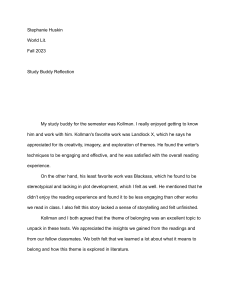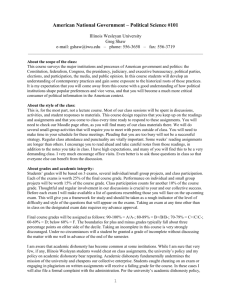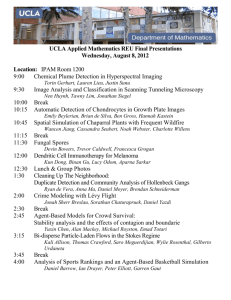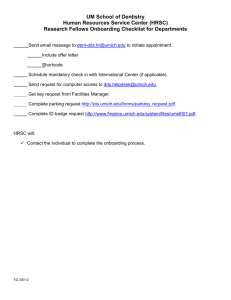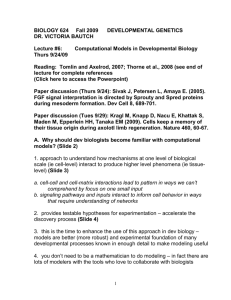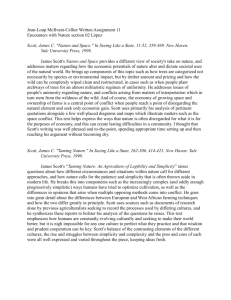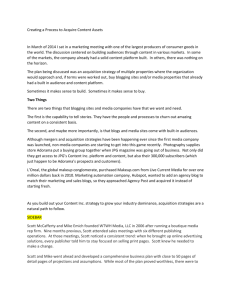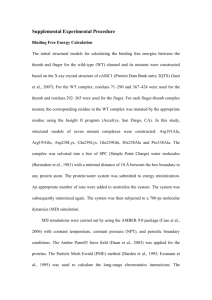msword version - Center for the Study of Complex Systems
advertisement
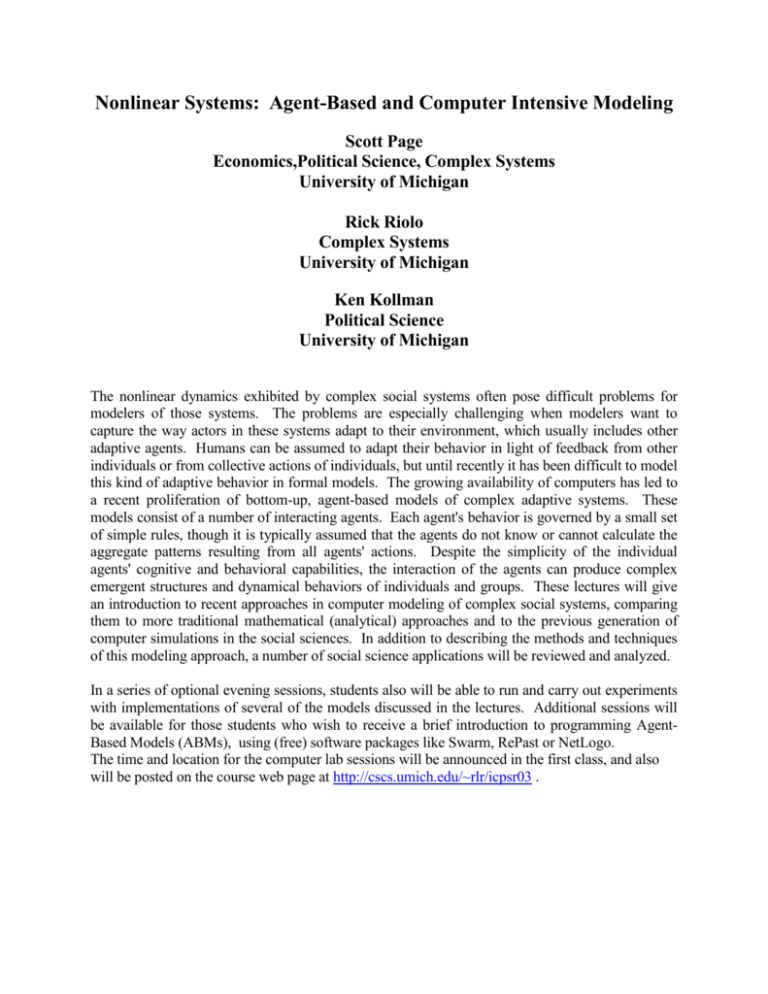
Nonlinear Systems: Agent-Based and Computer Intensive Modeling Scott Page Economics,Political Science, Complex Systems University of Michigan Rick Riolo Complex Systems University of Michigan Ken Kollman Political Science University of Michigan The nonlinear dynamics exhibited by complex social systems often pose difficult problems for modelers of those systems. The problems are especially challenging when modelers want to capture the way actors in these systems adapt to their environment, which usually includes other adaptive agents. Humans can be assumed to adapt their behavior in light of feedback from other individuals or from collective actions of individuals, but until recently it has been difficult to model this kind of adaptive behavior in formal models. The growing availability of computers has led to a recent proliferation of bottom-up, agent-based models of complex adaptive systems. These models consist of a number of interacting agents. Each agent's behavior is governed by a small set of simple rules, though it is typically assumed that the agents do not know or cannot calculate the aggregate patterns resulting from all agents' actions. Despite the simplicity of the individual agents' cognitive and behavioral capabilities, the interaction of the agents can produce complex emergent structures and dynamical behaviors of individuals and groups. These lectures will give an introduction to recent approaches in computer modeling of complex social systems, comparing them to more traditional mathematical (analytical) approaches and to the previous generation of computer simulations in the social sciences. In addition to describing the methods and techniques of this modeling approach, a number of social science applications will be reviewed and analyzed. In a series of optional evening sessions, students also will be able to run and carry out experiments with implementations of several of the models discussed in the lectures. Additional sessions will be available for those students who wish to receive a brief introduction to programming AgentBased Models (ABMs), using (free) software packages like Swarm, RePast or NetLogo. The time and location for the computer lab sessions will be announced in the first class, and also will be posted on the course web page at http://cscs.umich.edu/~rlr/icpsr03 . Class Schedule Week One – Ken Kollman July 21: Introduction to Complex Systems, (Kollman) Axelrod, Robert. 1997. The Complexity of Cooperation. Basic Books. Introduction. Schelling, Thomas (1978) Micromotives and Macrobehavior. Pp. 147-165: Simple models of segregation. Norton, New York, 1978. Page, Scott (1999). "Computational models from A to Z." Complexity 5 (1): 35-41. http://www.santafe.edu/projects/swarm/swarmfest99/keynote.html July 22: Genetic Algorithms, The Evolution of Strategies (Kollman) Holland, John. 1992. "Complex Adaptive Systems." Daedalus 121: 17-30. Holland, John. 1992. "Genetic Algorithms." Scientific American. July. pp. 66-72. Axelrod, Robert. 1997. The Complexity of Cooperation. Basic Books. Chapter 1. Miller, John H.. 1996. "The Coevolution of Automata in the Repeated Prisoner's Dilemma." Journal of Economic Behavior and Organization 29:1. July 23: Models of Culture and Norms (Kollman) Axelrod, Robert. 1997. The Complexity of Cooperation. Basic Books. Introduction, Chapters. 3, 7 July 24: Models of Domestic Political Competition (Kollman) Kollman, Ken, John Miller, and Scott Page. 1992. "Adaptive Parties and Spatial Elections." American Political Science Review 86: 929-937. Kollman, Ken, John Miller, and Scott Page. 1998. "Political Parties and Electoral Landscapes." British Journal of Political Science 28: 139-58. Kollman, Ken, John Miller, and Scott Page. 1997. "Political Institutions and Sorting in a Tiebout Model." American Economic Review 87: 977-92. July 25: Models of Markets (Kollman) Arthur, W. Brian, John H. Holland, Blake LeBaron, Richard Palmer, and Paul Taylor. 1997. "Asset Pricing Under Endogenous Expectations in an Artificial Stock Market." In W. Brian Arthur, Steven N. Durlauf, and David A. Lane (Eds). The Economy as a Complex System II. Reading, Massachusetts: Addison-Wesley. Pp. 15-44. Tesfatsion, Leigh. 1997. "How Economists Can Get A Life," in W. Brian Arthur, Steven Durlauf, and David Lane, eds. The Economy as an Evolving Complex System II. Reading, MA: Addison-Wesley Week Two -- Rick Riolo July 28: Agent-Based Models of Complex Adaptive Systems. Bonabeau, Eric (2002). “Agent-based modeling: Methods and techniques for simulating human systems.” Proc. Natl. Acad. Sci. USA, Vol 99 (Supp. 3), 7280-7297. Casti, John (1997) Would-Be Worlds: How Simulation is Changing the Frontiers of Science. Wiley, NY. Pp. 12-31 Rauch, Jonathan (2002). “Seeing Around Corners.” The Atlantic Monthly, April 2002. http://www.theatlantic.com/issues/2002/04/rauch (There are some online animations that are useful.) http://www.pnas.org/content/vol99/suppl_3/ Axtell, Robert (2000). “Why Agents? On the Varied Motivations For Agent Computing in the Social Sciences.” Brookings Institute CSED Working Paper #17, http://www.brook.edu/dybdocroot/es/dynamics/papers/agents/agents.htm Optional: Bankes, Steve (1993) "Exploratory Modeling for Policy Analysis." Operations Research 41(3): 435-449. Parunak, H. Van Dyke, Savit, Robert and Riolo, Rick. (1998) "Agent-Based Modeling vs. Equation-Based Modeling: A Case Study and Users' Guide." In Proc. Of Workshop on Multi-agent systems and Agent-based Simulation (MABS '98), Springer. http://www.erim.org/~van/mabs98.pdf July 29: Who Interacts with Whom? Barabasi, A. Linked: The New Science of Networks. (2002) Chapters 3-6, 10, 14. (Easy reading!) Optional: 7, 9 (and the rest!). Epstein, Joshua M. (1998) "Zones of Cooperation in Demographic Prisoner's Dilemma." Santa Fe Institute Working Paper SFI-97-12-094. Complexity 4(2): 36-48. http://www.santafe.edu/sfi/publications/Working-Papers/97-12-094E.html Riolo, Rick, Axelrod, Robert and Cohen, Michael D. (2001) “Evolution of Cooperation without Reciprocity.” Nature 414 (Nov 2001): 441-443. http://cscs.umich.edu/research/carReports.html Nowak and Sigmund, K. “Evolution: Tides of Tolerance.” Nature 414 (Nov 2001): 401-403. (commentary on the Riolo etal paper in the same issue.) http://cscs.umich.edu/research/carReports.html Optional: Axtell, Robert (2000) "Effects of Interaction Topology and Activation Regime in Several Multi-Agent Systems." In Multi-Agent Based Simulation, Scott Moss and Paul Davidson (eds), pp 33-48 of the In Proceedings of the 2nd International Workshop (MABS-2000). Andreas Flache and Rainer Hegselmann (2001) “Do Irregular Grids make a Difference? Relaxing the Spatial Regularity Assumption in Cellular Models of Social Dynamics.” J. Artificial Societies and Social Simulation 4 (4). http://www.soc.surrey.ac.uk/JASSS/4/4/6.html Cohen, Michael D., Rick L. Riolo and Robert Axelrod (1999) "The Emergence of Social Organization in the Prisoners' Dilemma: How Context-Preservation and other Factors Promote Cooperation." Santa Fe Institute Working Paper SFI-99-01-002. http://cscs.umich.edu/research/carReports.html Duncan Watts. Six Degrees of Freedom. (Norton, 2003). July 30: Emergence: Co-Adaptation and Perpetual Novelty Arthur, Brian W. (1994) "Inductive Reasoning and Bounded Rationality." Amer. Econ. Assoc. Papers and Proc. 84: 406-411. Casti, John L. (1996) "Seeing the Light at the El Farol." Complexity 1: 7-10 Edmonds, Bruce (1999) "Gossip, Sexual Recombination and the El Farol Bar: Modeling the Emergence of Heterogeneity." J. Artificial Societies and Social Simulation (JASSS) 2 (3). http://www.soc.surrey.ac.uk/JASSS/2/3/2.html Optional: Challet, D. and Y. C. Zhang (1997) "Emergence of Cooperation and Organization in an Evolutionary Game." Physica A 246: 407. Online at: http://xxx.sissa.it/abs/adap-org/9708006 Fogel, D. B., K. Chellapilla, and P. J. Angeline (1999). "Inductive Reasoning and bounded Rationality Reconsidered" IEEE Transactions on Evolutionary Computation 3(2): 142-- . http://vision.ucsd.edu/~kchellap/papers/FogelChellapillaAngelineTEC1999v3n2.zip July 31: Simulating Societies Epstein, Joshua M. and Axtell, Robert L. (1996) Growing Artificial Societies: Social Science from the Bottom-Up. The MIT Press. Selected Chapters: I, II, IV Gerard Weisbuch etal. (2002). “Meet, Discuss, and Segregate!” Complexity 7 (3): 55-63. http://www3.interscience.wiley.com/cgi-bin/jtoc?ID=38804 (The figures in color online are useful.) M.A.Makse etal (1995) “Modeling urban growth patterns.” Nature 377: 608-612. (See also Makse’s home page, which has a summary and links to other related papers, at: http://polymer.bu.edu/urban.html ) August 1: Things That Go Bump in the Night: Verification, Validation and Related Issues Axtell, Robert L. and Epstein, Joshua M. (1994) "Agent-Based Modeling: Understanding Our Creations." The Bulletin of the Santa Fe Institute, Winter, 1994, p28-32. Bankes, Steven C. (2002) “Tools and techniques for developing policies for complex and uncertain systems.” Proc. Natl. Acad. Sci. USA 99 (Supp. 3): 7263-7266. http://www.pnas.org/content/vol99/suppl_3/ Miller, John. (1996) "Active Nonlinear Tests (ANTs) of Complex Simulation Models." Management Science 44(6): 820-830 (June 1998). A working paper version Santa Fe Institute Working Paper 96-03-011. http://www.santafe.edu/sfi/publications/Abstracts/96-03-011abs.html Railsback, Steven F. (2002) “Getting Results: The Pattern-oriented Approach to Analyzing Natural Systems with Individual-based Models.” Natural Resource Modeling 14: 465-474. http://weasel.cnrs.humbolt.edu/~simsys/POTestPub.html Optional: Axtell, Robert, Axelrod, Robert, Epstein, Joshua, and Cohen, Michael (1995) "Aligning Simulation Models: A Case Study and Results." Santa Fe Institute Working Paper 95-07-065. Ferrenberg, Alan M., Landau, D.P., and Wong, Y. Joanna (1992) "Monte Carlo Simulations: Hidden Errors from 'Good' Random Number Generators.” Physical Review Letters 69 (23). See also News and Views in Nature 372, 1 Dec. 1994. Week Three -- Scott Page August 4: Complexity and Self Organized Criticality Per Bak. 1997. How Nature Works, Chapter 1 Ishii, Page and Wang. 1999. "A Day at the Beach: Human Agents Self-Organizing on the Sand Pile." Advances in Complex Systems 2(1): 37-63. August 5: Modeling Diverse Agents Johnson, Norman. 1999. "Diversity and Robustness: Collective Problem Solving: Functionality beyond the individual." Submitted for publication. Online at http://ishi.lanl.gov/Documents/NLJsims_AB_v11.pdf Hong, L, and S. Page. 2001. "Problem Solving by Heterogeneous Agents." Journal of Economic Theory 97(1): 123-163. August 6: Culture. Axelrod, Robert, “Disseminating Culture” Journal of Conflict Resolution, 1997 Bednar, Jenna and Scott Page, "Games Theory and Culture." See Jenna Bednar’s web site http://www-personal.umich.edu/~jbednar August 7: Emergence (Page) Page, S. 1999. "On the Emergence of Cities." Journal of Urban Economics 45: 184-208. Forrest, S. 1990. "Emergent Computation: Self-Organizing, Collective, And Cooperative Phenomena in Natural and Artificial Computing Networks." Physica D 42: 1-11. Crutchfield, James, Melanie Mitchell, and Rajarshi Das, 1999. "The Evolutionary Design of Collective Computation in Cellular Automata." Paper under submission, available from: http://www.santafe.edu/projects/evca/evabstracts.html#EvDens August 8: Uncertainty, Complexity, and Difficulty. Page, S. 1996. ``Two Measures of Difficulty.'' Economic Theory 8: 321--346. Week Four -- Ken Kollman and Scott Page August 11: Models of International Relations (Kollman) Axelrod, Robert. 1997. The Complexity of Cooperation. New York: Basic. Chapters 4, 6. Cederman, Lars-Erik. 1997. Emergent Actors in World Politics. Princeton: Princeton University Press. Selected chapters, TBA. August 12: Testing Models of Political Competition (Kollman) Bendor, Diemeier, and Ting, “A Behavioral Model of Turnout.” APSR 2003. Available at http://www.columbia.edu/~mmt2033/ August 13: Combining Mathematics and Computation “An Ecological Model of Chains and Barriers.” Available at: http://www-personal.umich.edu/~ttassier/#D August 14: Path Dependence No reading.
